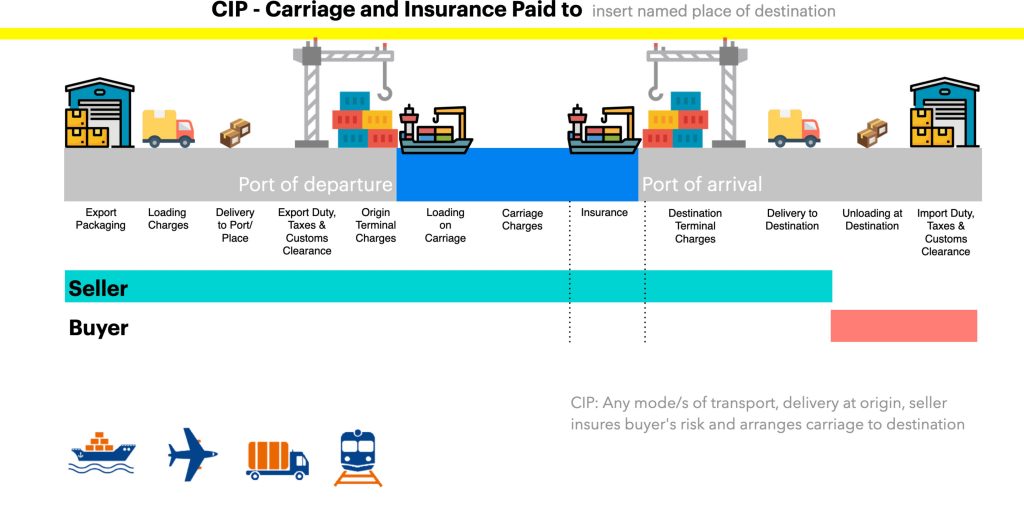CIP (Carriage and Insurance Paid To)
is one of the 11 Incoterms defined in the Incoterms 2020, published by the International Chamber of Commerce (ICC). It is an Incoterm that is commonly used in international trade when the buyer and seller are located in different countries and the seller is responsible for arranging and paying for the transportation of the goods to a named destination, as well as obtaining insurance for the goods.
Under CIP, the seller is responsible for arranging and paying for the transportation of the goods to a named destination, obtaining any necessary export licenses or permits, and obtaining insurance for the goods against the usual transport risks from the place of origin to the named destination. The buyer is responsible for obtaining any necessary import licenses or permits and for paying any applicable duties or taxes. The risk of loss or damage to the goods passes from the seller to the buyer when the goods are handed over to the first carrier.

Responsibilities and Obligations of Buyer and Seller
- The seller's responsibilities under CPT include:
- Arranging and paying for the transportation of the goods to a named destination
-
- Obtaining any necessary export licenses or permits
-
- Arranging and paying for the transportation of the goods to a named destination
- The buyer's responsibilities under CPT include:
- Obtaining any necessary import licenses or permits
- Paying any applicable duties or taxes
- Bearing the risk of loss or damage to the goods once they are handed over to the first carrier
Advantages of using CIP include:
- The seller is responsible for arranging and paying for the transportation of the goods to a named destination, which can be beneficial for the buyer if they do not have the resources or capabilities to arrange transportation themselves.
- The buyer can arrange for the goods to be shipped directly to the final destination, avoiding the need for transshipment
- The seller is also responsible for obtaining insurance for the goods which can provide additional protection for the buyer.
Disadvantages of using CIP include:
- The buyer is still responsible for obtaining any necessary import licenses or permits and paying any applicable duties or taxes
- The buyer bears the risk of loss or damage to the goods once they are handed over to the first carrier
Examples of when to use CIP include:
- When the buyer is located in a country with a well-established customs clearance process and minimal import restrictions
- When the seller has established relationships with carriers and can obtain favorable transportation rates
- When the buyer does not have the resources or capabilities to arrange transportation themselves.
- When the buyer wants added insurance protection for the goods in transit.
It’s important to note that CIP is a more advanced Incoterm than EXW, FCA, FAS, FOB, and CPT and it shifts some of the responsibilities and risks from the buyer to the seller. It’s important for both buyer and seller to carefully consider their capabilities and resources before choosing to use CIP in a trade agreement, and to consult with legal and logistics experts to ensure compliance with laws and regulations. Additionally, it’s important to agree and specify the exact place of destination, the type of insurance coverage, and any other relevant details in the sales contract. It’s also important to check that the insurance coverage provided by the seller is adequate and meets the buyer’s requirements.
